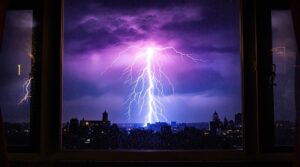Lightning strikes can occur inside a house when electrical discharges from a thunderstorm travel through conductive pathways, such as electrical wiring, plumbing, and phone lines. This poses a significant risk to occupants and property. One-third of lightning-strike injuries occur indoors, often resulting from lightning entering through these pathways. Understanding how lightning enters homes and taking preventative measures can help mitigate risks. Further exploration of indoor lightning strikes reveals key safety precautions and effective protection strategies.
Key Takeaways
- One-third of lightning-strike injuries occur indoors when lightning enters through conductive pathways like electrical wiring and plumbing systems.
- Metal piping in older homes can conduct electricity from a lightning strike, making them more hazardous during storms.
- Openings in the home should be minimized to reduce entry points for lightning, including keeping windows and doors closed.
- Staying away from conductive paths and unplugging devices before a storm helps prevent injury and damage from indoor lightning strikes.
- Modern homes with PVC plumbing and surge protection systems can reduce the risk of injury and damage from indoor lightning strikes.
Why Lightning Strikes Inside a House Are Possible
A significant proportion of lightning-strike injuries occur indoors, with approximately one-third of all cases happening while individuals are inside their homes. Indoor strikes are often a result of lightning entering the house through conductive pathways, including electrical wiring, phone lines, and plumbing systems. Metal piping, commonly found in older homes, can also conduct electricity from a lightning strike, posing a hazard to occupants who come into contact with plumbing fixtures during a storm. To mitigate the risk, it is essential to take precautions such as unplugging electronic devices to prevent power surges. Installing a lightning protection system can also provide a safe path for lightning to follow, reducing the risk of damage to the home. By understanding the risks and taking necessary precautions, individuals can minimize their risk of injury from indoor lightning strikes and stay safe while indoors during a storm.
Paths of Least Resistance: How Lightning Enters Homes
Numerous pathways allow lightning to enter homes, where it can cause significant damage and pose a threat to occupants. Homes often have conductive materials like metal plumbing, electrical systems, and metal conduits that provide these pathways.
When lightning strikes nearby, it can follow the paths of least resistance to enter the home. Knowing how lightning can enter homes can help take preventative measures.
Here are some common pathways:
- Electrical Systems: Lightning is capable of traveling through electrical systems, creating surges that damage devices even if they are not directly struck.
- Plumbing Systems: Metal plumbing can conduct electricity, making contact with fixtures dangerous during a storm, while modern PVC pipes reduce this risk.
- Conductive Materials: Metal conduits and other materials can carry electrical currents from lightning, posing a threat to occupants.
- Openings in the Home: Keeping windows and doors closed can help minimize the chance of lightning entering through openings or conductive materials.
Protecting Your Home and Family From Indoor Lightning
While the odds of being struck by lightning are relatively low, the consequences of a strike can be severe, especially when it occurs indoors. To minimize risks, households should take preventative measures during a lightning storm. This includes staying away from windows, unplugging devices, and avoiding the use of landline phones. Furthermore, refraining from using plumbing fixtures during a storm is vital, especially in homes with older metal pipes, as lightning can impart an electrical charge to the metal plumbing.
It is also essential to have a trustworthy electrician inspect and install surge protection systems, which can be up to 99% effective in preventing damage from lightning. In case of a strike, if you smell smoke, call the fire department immediately. Staying inside and following safety guidelines greatly reduces the risk of injury from shock waves and potential fires, ensuring the household's safety during a lightning storm.
Preparing for and Responding to Indoor Lightning Strikes
Households that have taken preventative measures to minimize the risks associated with indoor lightning strikes must also be prepared to respond effectively in the event of a strike. When lightning strikes, staying indoors and avoiding conductive materials can enhance indoor safety. Modern PVC pipes reduce the risk of electrical shock from plumbing fixtures, which are good conductors of electricity.
Key steps to respond to indoor lightning strikes:
- Unplugging devices: Unplug electronic devices to prevent power surges and damage from lightning strikes.
- Staying informed: Monitor weather updates and wait for confirmation that the storm has passed before resuming normal activities.
- Seeking help: If a household member is struck by lightning, call emergency responders immediately and provide first aid if possible.
- Checking for damage: After the storm has passed, inspect the home for damage and verify that loved ones are safe and accounted for.
Safety Precautions for Minimizing Indoor Lightning Risks
Several key safety precautions can greatly minimize the risks associated with indoor lightning strikes. When thunder roars, it is essential to stay indoors and avoid contact with conductive paths such as electrical wiring, metal pipes, and plumbing systems. Unplugging electrical devices before a storm can prevent damage from potential surges caused by lightning strikes. Additionally, avoiding the use of landline phones during thunderstorms reduces the risk of injury, as lightning can travel through phone lines.
Modern PVC plumbing reduces the risk of lightning-related injuries compared to older metal plumbing systems. However, caution is still advised during storms. Staying away from windows and avoiding activities that involve running water, such as showering or washing dishes, minimizes the risk of injury from indoor lightning strikes. By taking these safety precautions, individuals can reduce their risk of injury and guarantee a safe environment during thunderstorms, thereby avoiding the need for first aid.








